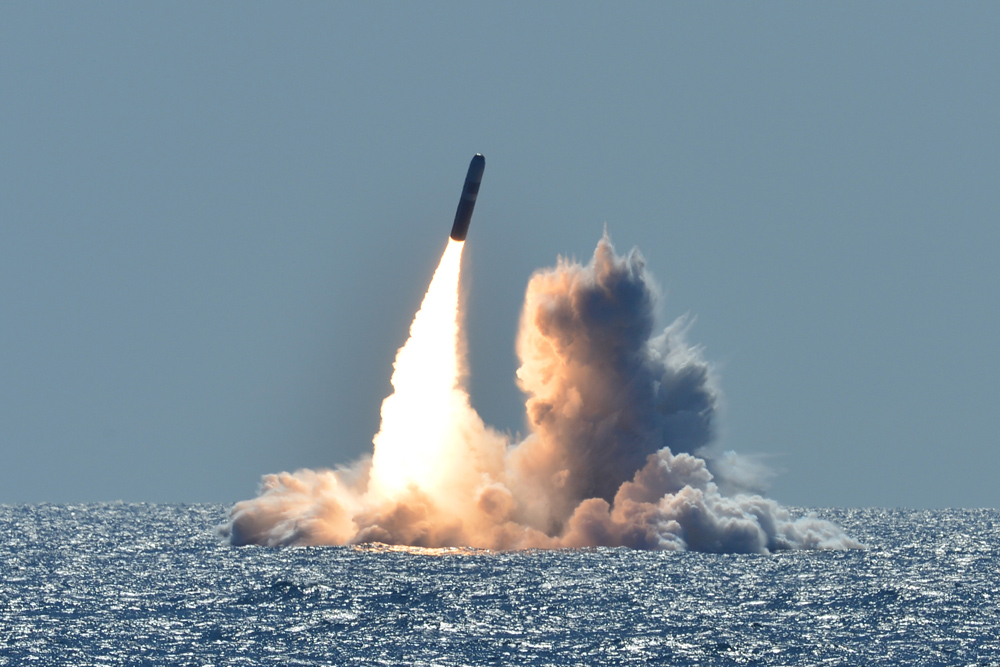 The U.S. under President Biden is not willing to risk nuclear escalation on behalf of Ukraine, which is why Russian nuclear blackmail is succeeding. Throughout the Cold War, and today, in order to prevent nuclear war, it is foundational to the concept of deterrence that the U.S. should allow no nuclear adversary to achieve significant advantages in the balance of nuclear power. Pictured: The test-launch of an unarmed Trident II D5 missile from the Ohio-class ballistic missile submarine USS Nebraska off the coast of California. (Image source: U.S. Navy/Ronald Gutridge/Released) The U.S. under President Biden is not willing to risk nuclear escalation on behalf of Ukraine, which is why Russian nuclear blackmail is succeeding. Throughout the Cold War, and today, in order to prevent nuclear war, it is foundational to the concept of deterrence that the U.S. should allow no nuclear adversary to achieve significant advantages in the balance of nuclear power. Pictured: The test-launch of an unarmed Trident II D5 missile from the Ohio-class ballistic missile submarine USS Nebraska off the coast of California. (Image source: U.S. Navy/Ronald Gutridge/Released) |
U.S. President Joe Biden, overruling his top generals and military advisors in the Pentagon, has defunded development of the Sea-Launched Cruise Missile-Nuclear (SLCM-N). They warn, correctly, that SLCM-N is vitally necessary for nuclear deterrence.
Throughout the Cold War, and today, in order to prevent nuclear war, it is foundational to the concept of deterrence that the U.S. should allow no nuclear adversary to achieve significant advantages in the balance of nuclear power.
SLCM-N, if developed and deployed, would be a long-range (2,500 km) cruise missile, stealthy because it can fly under radar, highly accurate, armed with a warhead of variable yield (5-150 kilotons), and launchable from U.S. Navy tactical platforms, submarines and surface ships, including nuclear-powered attack submarines (SSNs), guided missile cruisers, and destroyers.
SLCM-N was the best hope to mitigate Russia’s enormous advantage in tactical nuclear weapons. Currently, the U.S. is credited with 100-200 tactical nuclear weapons, mostly aged gravity bombs bunkered in European NATO countries and Turkey (at Incirlik), versus an estimated 2,000-8,000 Russian tactical nuclear weapons — giving Moscow an at least ten-to-one decided advantage that Russia may exploit by waging nonstrategic nuclear warfare in land, sea, and air battles.
SLCM-N defunding appears to show that the Biden Administration to genuinely believes its mantra that “Nuclear war cannot be won and must never be fought,” so U.S. gross inferiority in tactical nuclear weapons matters not — Minimum Deterrence will suffice.
The Problem with U.S.-NATO Tactical Nuclear Weapons
While the U.S. credits itself with 100-200 tactical nuclear weapons, from the perspective of our nuclear adversaries, we are probably giving ourselves too much credit.
Most U.S. tactical nuclear weapons are aged, arguably obsolete, gravity bombs that would have to be delivered through increasingly formidable Russian air defenses. Nor can the U.S. unilaterally employ these weapons. The U.S. must consult with other NATO governments and have the approval of at least the host government — which would deliver the bombs on behalf of NATO.
Would Germany, Italy or Turkey really be willing to risk a nuclear war with Russia, or to widen a tactical nuclear war started by Russia to include themselves as targets, on behalf of Latvia, Poland or Ukraine? Indeed, the U.S. under President Biden is not willing to risk nuclear escalation on behalf of Ukraine, which is why Russian nuclear blackmail is succeeding. Moreover, generating NATO’s tactical nuclear weapons for employment would be a “noisy” process that might well provoke a Russian preemptive nuclear strike.
The Problem with the W-76
The U.S. has a very small number of tactical nuclear warheads aboard the SSBN Tennessee, a ballistic missile submarine armed with mostly high-yield strategic warheads. Some of the Tennessee’s Trident SLBMs are armed with the W76-2, a low-yield (5 kilotons) tactical warhead.
Critics warn that the Trident missile lacks the necessary accuracy to usefully deliver 5 kilotons to a battlefield; that delivering a tactical nuclear strike from a strategic platform risks escalating a limited nuclear war into an all-out nuclear war; and that as soon as the submarine fires one or more missiles, the vessel exposes its location and could be destroyed, along with all its strategic warheads needed to deter attacks on U.S. cities.
Moreover, the Tennessee (the only submarine armed with W76-2 warheads) cannot always be at sea or in the theater where it is needed. If at port, the SSBN would have to be generated — a potentially escalatory act.
Why Deterrence is Needed
Chief of U.S. Strategic Command, Admiral Charles Richard, who also sits on the Nuclear Weapons Council in addition to commanding all U.S. nuclear forces, wants SLCM-N because, in addition to its accuracy and stealth, if widely deployed SLCM-N would not have to be generated: “I support reestablishing SLCM-N as necessary to enhance deterrence and assurance [because] a low-yield, non-ballistic capability that can be made available without visible generation” is needed.
Richard also warns that the disparity in U.S. and adversary nuclear capabilities increases the risk of limited nuclear war:
“We are facing a crisis deterrence dynamic right now that we have seen only a few times in our nation’s history…The war in Ukraine and China’s nuclear trajectory—their strategic breakout—demonstrates that we have a deterrence and assurance gap based on the threat of limited nuclear employment.”
The Defense Threat Reduction Agency’s Robert Peters, Chief of the Strategic Trends and Effects Department, concurs:
“China and Russia are incentivized to escalate the level of violence above the conventional threshold, but below a general nuclear exchange—and should that happen, those states are postured to defeat us.”
Peters assesses that limited nuclear use by Russia or China could strain U.S. alliance relationships beyond the breaking point — and that Moscow and Beijing know this:
“The political effect of responding either with conventional weapons or with high-yield nuclear weapons would create serious alliance cohesion issues within any U.S.-led coalition…Some allies might demand a nuclear response (even one that was high-yield) to a low-yield nuclear attack, while others would almost certainly blanche at the prospect of a limited nuclear war… The political crisis would be severe, immediate, and perhaps devastating to coalition cohesion. This is a prospect our enemies count on and is part of the reason why a low-yield nuclear strike would nonetheless have strategic political impacts…
“And they are not problems which would confront China or Russia, non-democracies who do not have to worry about offending allies…
“We must examine the strategic and operational and tactical warfighting challenges. And we must re-examine our force posture as well as our declaratory policy…
“If we do not, we will lose the war.”
SLCM-N could close the enormous gap between U.S. and adversary capabilities to wage tactical nuclear warfare, plugging one of the biggest holes in the eroding nuclear deterrence dike. But President Biden is ignoring pleas for SLCM-N even from his own top military experts.

























